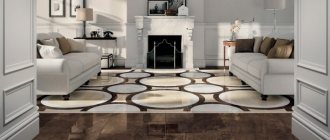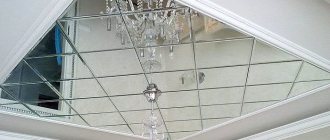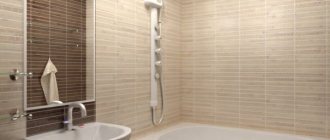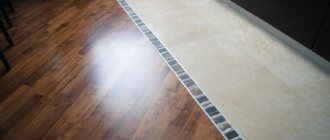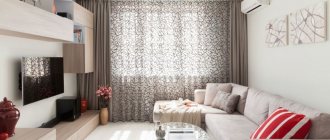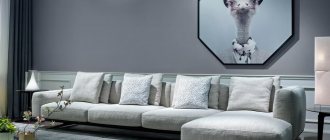Help the site, share with friends:
It is believed that ceramic tiles are a facing material only for finishing a bathroom (bathtub) or kitchen, but this opinion is erroneous.
Today, collections of beautiful and high-quality tiles allow this material to be harmoniously integrated into the design of the living room, in such a way that it will give the room completeness, originality and aesthetics.
Ceramic tiles in the living room vary in functionality:
- Floor-mounted, used only for covering the floor.
- Wall-mounted, for finishing wall surfaces.
- Decorative, used as surface decoration.
Why choose floor tiles
Interior tiles produced by manufacturers are suitable for decorating walls, floors and even ceilings, but at the same time they differ in performance qualities. Home owners are faced with a difficult choice before the upcoming renovation, which depends on the drafted project.
When choosing flooring, many choose tiles for the living room floor
, considering that the use of such materials has undeniable advantages:
- extended service life if care recommendations are followed
- high level of resistance to mechanical stress and abrasion
- a huge selection of colors, sizes and shapes, materials of manufacture
It cannot be said that certain types of floor tiles have only advantages; such coatings also have disadvantages. For example, ceramic tiles can be cold and to neutralize this disadvantage, you can use floor heating systems to avoid discomfort.
Another nuance is that the surface of the coating is too smooth; tiles with a glossy finish are quite slippery, so your choice must be taken as carefully as possible.
Linoleum
Linoleum is classified into several types, the most popular of which are natural and polyvinyl chloride (PVC) products. The natural coating contains wood flour, linseed oil, pine resin, limestone powder and dyes. Polyvinyl chloride products are made on fabric, foam, or non-woven bases; they can be single- or multi-layer.
Pros:
- low price;
- It’s easy to lay linoleum yourself, without involving specialists;
- no need to apply protective coatings;
- the material is completely ready for installation;
- Moisture-resistant fabric can be laid in rooms where there is a high level of humidity.
Minuses:
- requires a perfectly level base;
- may rupture if something sharp falls on the surface. Linoleum can be easily damaged if heavy objects, such as a refrigerator or dining table, are moved across the floor. Of course, it is possible to repair the gap using cold welding, but the mark will still remain.
The best types of tiles for the living room
The floor in the living room, which is constantly walked on by people, homeowners, guests, and pets, wears out quickly. When choosing a floor covering, it is important to consider all options, and if the main requirement is practicality and wear resistance, you can pay attention to the following options:
- vinyl tiles for living room;
- rubber with additional decor;
- polyvinyl chloride coating;
- quartzvenile floor tiles;
- cork tiles (natural material);
- natural stone floor tiles;
- ceramic, the most common tile.
An interesting and unusual solution would be mirror tiles in the living room interior
with a glossy and reflective coating. This option can be used in combination with other floor coverings as part of finishing or decorative elements, increasing the uniqueness of the room's interior.
Ceramics and its types
The beauty and attractiveness of the interior depends on the harmony and atmosphere of comfort, which can be created by the correct choice of all types of finishing.
The most popular combination of affordable cost and high quality is ceramic tiles, which come in different types:
- metlakhskaya, without a glazed coating and painted through;
- Cotto, with a porous structure and without enamel on the surface;
- clinker, extremely wear-resistant and not very porous in structure;
- porcelain stoneware with a glossy surface and homogeneous structure.
Almost all types of ceramic tiles are easy to care for and install, and do not collapse under prolonged exposure to chemically active substances.
To clean ceramics, you can use strong products that help clean and disinfect the surface while maintaining its attractive appearance.
Technology Features
Ceramic floor tiles for living room
when heated or supercooled, it does not emit harmful substances into the air and has no specific odor. This flooring is produced using modern technologies that differ in certain nuances of production organization:
- extrusion, forcing a plastic mass through special devices;
- pressing, for this process the charge is compacted and given the desired shape;
- monocottura, the dried mass after pressing is treated with glaze;
- bicottura, instead of glaze, high-quality enamel is used for such products.
Depending on the technology used, the finished product has its own distinctive properties. Knowing what technological process was used, you can focus on the properties acquired by the tile, which is important when choosing the best material for decorating the living room.
Tile design
In modern interiors, tiles are often found on the living room floor, photo
finished projects can be used for upcoming renovations. In this case, it is necessary to take into account the design features of the room, the style and the general concept of decorating the room.
Tile design
The varied shapes, textures and shades of ceramic coatings allow the apartment owner to decorate the living room in any way.
To expand the space of the room and give it airiness, the walls are decorated with mirror tiles. The wood-effect covering will add a touch of naturalness and comfort to the decor. You can also combine tiles with laminate by cutting out a curly line and covering it with an elastic threshold. “Marbled” products look great in the interior of the hall. To imitate carpeting, patterns with ornaments are used.
The photo shows an airy living room with sky-colored details. Mirror tiles emphasize the lightness of the decor and visually add space.
Connoisseurs of country style will love the cladding option in the form of panels made of combined tiles of different colors. This technique is called patchwork.
The shape of tiles today is the most diverse - designers offer not only squares and rectangles, but also rhombuses, honeycomb-shaped polyhedrons, and shaped products with rounded elements.
Using stone-like tiles, you can decorate the walls of the living room (either completely or partially), border windows, columns and doorways. Mosaic is suitable for facing fireplaces, as well as decorating walls: it is recommended to place it in inserts so as not to overload the space.
Laying rules and design options
Depending on the shape and size of the individual elements of the floor covering, the method of its installation is also selected. In the assortment of modern manufacturers you can also find ready-made kits, which include design projects; they are placed in the center or in the corners of the room, complemented by a background covering.
Stylistic nuances
Looking at the tile floors in the living room, photo
who are inspired to decorate their own home, you can choose the best style option.
Large or small drawings, geometric shapes and optical illusions are quite popular among modern designers.
What is important to consider when choosing
When choosing high-quality and inexpensive tiles, it is necessary to take into account its environmental friendliness and compliance with sanitary requirements. The higher the porosity of the structure, the greater the likelihood of poor maintenance, but we must not forget about the appearance of the coating, because the tiles should decorate the room.
When planning an upcoming renovation, it is important not to forget about the floor covering, and if you plan to install a heated floor system, tiles will be an ideal option. It warms up well and retains heat for a long time, and in the hot season it gives coolness, decorating the room.
Kitchen-living room tiling ideas
If the apartment has a living room combined with a kitchen, tiled flooring will suit perfectly. A standard practical option is a kitchen apron. Recently, the rectangular “hog” has gained popularity: it looks advantageous in any style.
The photo shows a kitchen-living room, decorated with hexagonal “honeycombs” in pastel colors. They protect not only the walls, acting as an apron, but also the floor.
Porcelain tile flooring in the kitchen area is a good idea for practical people. Wear-resistant porcelain tiles will not wear out, absorb moisture and grease, or deteriorate under the influence of cleaning agents. Also, in a large room, zoning can be easily done using tiles.
In the photo there is a kitchen-living room, the division of zones occurs by combining floor tiles of different colors and shapes.
Photo of tiles in the living room interior
Share with friends:
